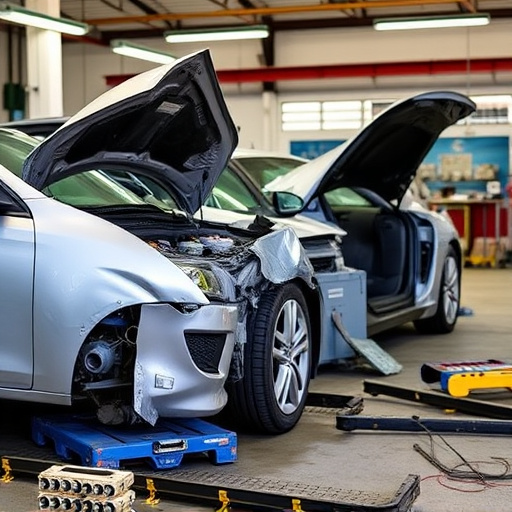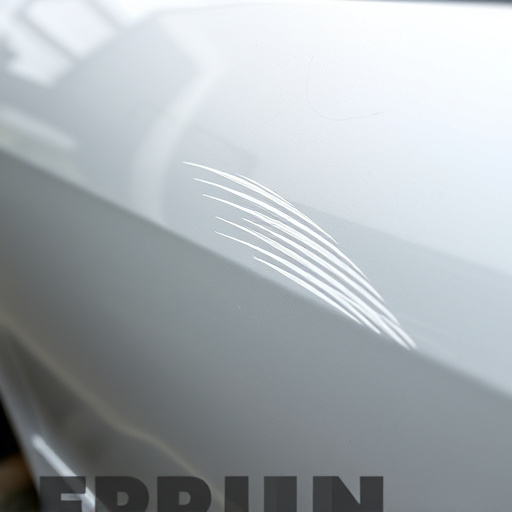Mercedes diagnostic systems, featuring onboard computers and sensor networks, monitor engine performance and exhaust gas emissions in real-time, enhancing safety and efficiency. These systems act as a guardrail for emission control, preventing minor issues from escalating into costly repairs, thus optimizing fuel efficiency and extending vehicle lifespans. Mechanics use these tools to accurately identify problems, ensuring flawless collision repairs and hail damage restoration, benefiting both owners and the environment.
Mercedes, a pioneer in automotive innovation, has transformed vehicle diagnostics with its advanced systems. This article explores the cutting-edge Mercedes diagnostic tools that detect emission and fuel efficiency issues, ensuring optimal performance. We delve into the intricate mechanisms of their emission control systems and the technology driving improved fuel efficiency. By understanding these technologies, car enthusiasts and professionals alike can grasp how Mercedes continues to set benchmarks in vehicle management and sustainability.
- Unveiling Mercedes' Advanced Diagnostic Tools
- Emission Control: A Deep Dive into the System
- Optimizing Fuel Efficiency through Technology
Unveiling Mercedes' Advanced Diagnostic Tools

Mercedes-Benz has long been at the forefront of automotive innovation, and their diagnostic systems are no exception. Unveiling Mercedes’ advanced diagnostic tools, such as the latest generation of onboard computers and sophisticated sensor networks, offers a glimpse into the future of vehicle maintenance. These cutting-edge technologies not only enhance safety features but also play a pivotal role in detecting emission and fuel efficiency problems early on.
By integrating smart sensors throughout the vehicle, Mercedes’ diagnostic system continuously monitors various components, from the engine’s performance to exhaust gas emissions. This proactive approach allows for precise identification of potential issues before they escalate. As a result, owners can benefit from more efficient fuel consumption, reduced environmental impact, and timely collision damage repair or maintenance at their trusted collision repair center, ensuring their vehicles remain in top condition.
Emission Control: A Deep Dive into the System

Mercedes diagnostic systems play a pivotal role in ensuring emission control, facilitating efficient and clean burning of fuel. At the heart of this mechanism lies a sophisticated network of sensors and actuators that continuously monitor various parameters within the engine and exhaust system. These sensors detect subtle changes in pressure, temperature, and chemical composition, feeding real-time data to the vehicle’s computer brain. This advanced technology enables precise adjustments to the injection of fuel and ignition timing, optimising combustion and minimising harmful emissions.
The Mercedes diagnostic system incorporates sophisticated algorithms that analyse data from these sensors, identifying anomalies indicative of potential issues. When emission control problems are detected, the system flags them, allowing drivers to address concerns promptly. This proactive approach not only helps in maintaining environmental standards but also contributes to the longevity of the vehicle, as regular monitoring can prevent minor issues from escalating into costly repairs. For auto body shops and vehicle collision repair centres, understanding these diagnostic systems is crucial for effective restoration of Mercedes vehicles, ensuring both safety and optimal performance.
Optimizing Fuel Efficiency through Technology

In today’s digital era, Mercedes has leveraged its advanced diagnostic systems to optimize fuel efficiency, addressing emission concerns and enhancing overall performance. These sophisticated tools enable mechanics to pinpoint issues with precision, be it sensor malfunctions causing incorrect fuel injection or inefficient combustion processes. By integrating these technological advancements into their repair processes, car body restoration specialists can ensure that every Mercedes benz collision repair is executed effectively.
Through the use of these diagnostic systems, hail damage repair experts can also mitigate the impact of external elements on a vehicle’s performance. Even subtle changes in sensor readings or engine parameters caused by incidents like hail storms can be detected and rectified, ensuring that the car operates at its optimal level. This not only extends the lifespan of the vehicle but also significantly improves fuel efficiency, contributing to both economic and environmental benefits.
Mercedes’ advanced diagnostic systems, such as its emission control and fuel efficiency optimization tools, represent a significant leap forward in automotive technology. By leveraging sophisticated sensors and data analysis, these systems not only ensure compliance with environmental regulations but also enhance overall vehicle performance. The continuous evolution of the Mercedes diagnostic system underscores the brand’s commitment to creating more efficient, eco-friendly, and reliable cars for the future.














